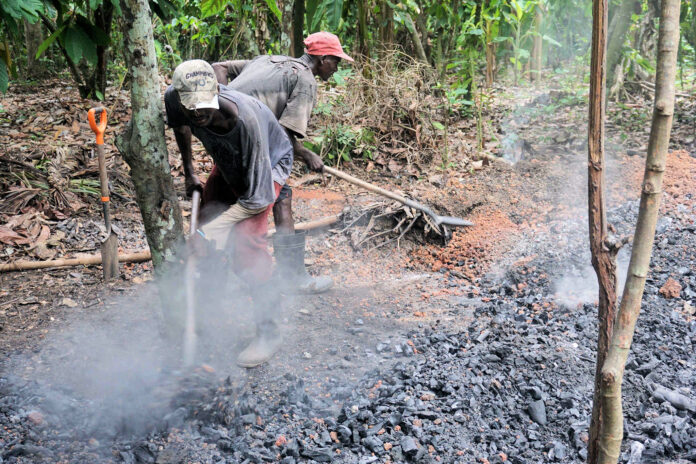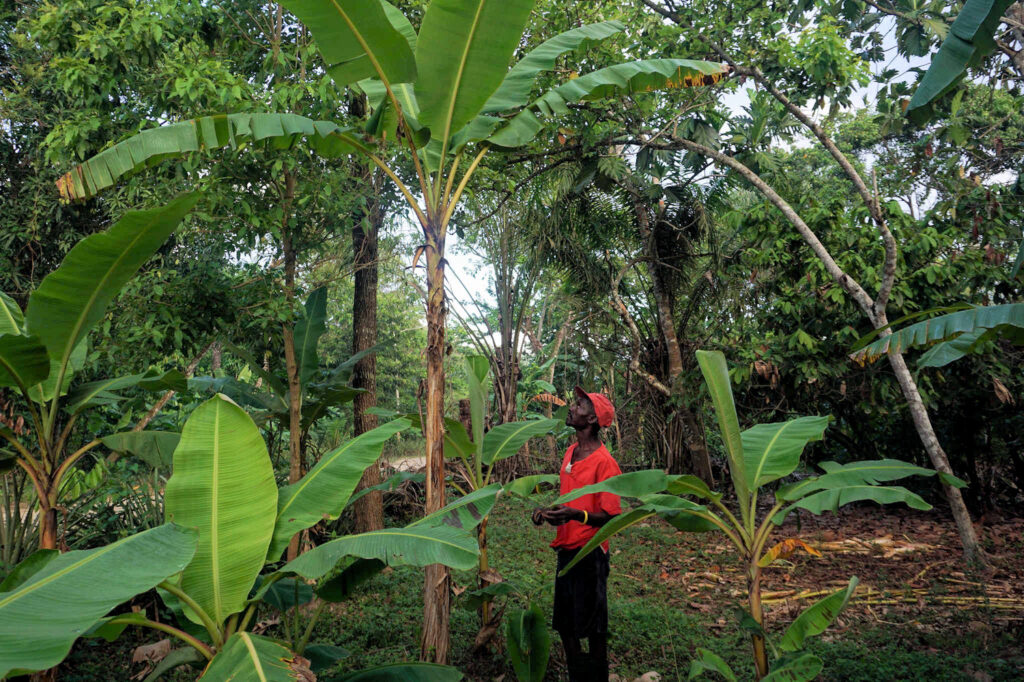
PORT-MARGOT, HAITI — Louis François grew up surrounded by hundreds of sweet orange trees. His father would sell his oranges 200 to 300 to a bag, and those that had already fallen to the ground were left for him and his siblings to eat.
“My father had about 360 sweet orange trees on his land in the mountains,” says François, who has followed in his father’s footsteps, making a living as a farmer on his family’s land in the Bas Petit-Borgne area of Port-Margot.
“He sold them to a Madan Sara from Port-au-Prince, who came to buy them in bags,” he says, referring to women who buy, distribute and sell food in Haiti. “The bag cost between 250 and 300 [United States] dollars at the time, but today all these orange trees have disappeared, and on my land, I have only two trees that are just beginning to grow.”
François has had to learn how to grow other produce such as bananas and yams. He is also a livestock breeder and charcoal producer but says he doesn’t reap as many rewards as his father did producing thousands of sweet oranges each year. The 46-year-old blames the loss on a disease that has wiped out orange trees in northern Haiti, an area known for growing the sweetest oranges in the country. The bacterial disease, Citrus Huanglongbing, has been present in Haiti for at least a decade. There is no cure, but there are ways of controlling it, something farmers say they need assistance with as they endure the loss of their orange plantations and earnings.

Photo: Wyddiane Prophète, GPJ Haiti
As Haitians grapple with rising food insecurity, the dwindling supply of sweet oranges affects the economy and pushes them to consume more and more expensive imported products. Agriculture contributes billions of dollars to Haiti’s economy, with a fifth of the country’s labor force employed in this sector. Fruit ranks second in Haiti’s exports to the U.S., one of its biggest trading partners, and the disease has left farmers in the area unable to reap the benefits of international demand for its fruit and the profits that accompany it.
In 2013, the Ministry of Agriculture, Natural Resource and Rural Development, through a statement on its website, announced the presence of the Citrus Huanglongbing disease in several areas of the country, including the north. While acknowledging that the disease did not pose a risk to human health, the department admitted it would affect citrus fruit and the country’s economy. Orange exports dropped more than 60% between 2017 and 2019, according to a report from agricultural company and social enterprise Selina Wamucii.
Huanglongbing is a bacterial disease considered the most devastating for citrus trees, causing a smaller fruit yield and eventually leading to the citrus tree’s death if not properly treated.
The country’s farmers are battling a steady decrease in rainfall each year, while temperatures continue to rise.
There is no known cure for the disease, but “some medicines have been widely used to ensure the healthy development of the citrus industry, such as antibiotics, pesticides, and immune inducers, which have achieved remarkable results,” according to a 2021 research paper published by science platform Frontiers. Haiti’s Ministry of Agriculture has encouraged farmers to cut down diseased trees and use layering, a propagation method in which low-hanging tree branches are buried to encourage them to grow roots, which are then separated and replanted, says Jean-François Emmanuel, in charge of crop production at the Direction Départementale Agricole du Nord, part of the Ministry of Agriculture. Emmanuel says Port-Margot was one of the first areas hit by the disease. But local farmers say this method alone isn’t enough to reestablish orange trees — they need more help.
Haiti has one of the highest levels of food insecurity in the world, nearly half of the population do not have enough food to eat, according to a 2023 World Food Programme report. When food is scarce people tend to rely on cheaper, less nutritious food. The reduction of this vital food group in the area means less access to a top source of vitamin C, which is vital for immunity and essential for cardiovascular health. Coronary heart disease is the leading cause of death in Haiti.
The sweet orange is one of the Caribbean country’s top fruits. It is mainly consumed fresh, or used to produce juice, jam, and cakes. Sweet orange oil is used in the perfume industry; in Haiti, orange peel is also used to make charcoal fires and is even used as fishing bait, according to a 2021 study conducted by the Research Institute for Development, a research agency in the French government. Port-Margot, a commune of almost 50,000 people, according to 2015 government figures, relies heavily on crops such as coffee, cocoa and fruit. The commune used to supply oranges to other regions, like Cap-Haïtien and Gonaives, even providing orange seeds to other areas. This is no longer the case.
“This variety of citrus fruit started disappearing in Port-Margot about 12 to 15 years ago,” says Germinal Jean-Claude, an agronomist in the region, “due to a disease in which yellow spots and a black powder similar to charcoal appear on the leaves of the orange trees, with an increasing reduction in the quantity of fruit produced, until they die.” The bacterial disease is said to kill a fruit tree in about five years.
Thélisma Elisnord is a farmer and former orange grower who lost his trees to the disease and now grows yams and bananas, and breeds oxen. He works his land alone while his wife and daughters sell what he produces. He says oranges offered vital income for him and many others in the area, but he also misses having a regular supply for his family.

“When an orange tree was cut down, the inside was completely eaten up, leaving only a huge empty hole,” Elisnord recalls of the disease that killed his trees. He attempted to plant new ones, losing them each time to the bacterial infection.
As orange trees succumb to this disease and farmers switch to growing other produce, they face new challenges in Haiti’s changing weather patterns. The country’s farmers are battling a steady decrease in rainfall each year, while temperatures continue to rise.
Jocelin Oremis, a farmer from Bas Petit-Borgne who used to grow sweet oranges, explains that one of the problems is drought. Like many of his peers, he lost his pistachio crop this year. Others have lost entire harvests of beans and other crops because of the lack of water.
Port-Margot, a commune of almost 50,000 people, relies heavily on crops such as coffee, cocoa and fruit.
“It would be great if we could not only find new plants but also get some help with the [lack of] water, which is a real ordeal for us at the moment, as we are losing almost everything we have planted,” Oremis says. Yet some fruits and vegetables have proven hardier in the face of harsher and changing weather patterns. Among these are oranges.
A 2018 report from global research nonprofit World Resources Institute, which studied farmers in Costa Rica who switched from growing coffee to oranges because of changing weather patterns, found oranges more resilient to the “droughts, floods, uneven temperatures, erratic rainfall and higher winds that climate change is bringing.”
Germinal says that to replace the hardy orange tree, authorities need to consider sustainable solutions to the difficulties, starting with the creation of new orange plantations to replace the old ones.
“Since the arrival of this plague, only one agronomist has come to distribute new orange seedlings to the farmers of my section, and for my part, when I eat oranges, I always keep the seed to put back in the ground, hoping it will take root,” says François, who now grows bananas and yams in place of the orange trees he lost.
“It would be good if new nurseries were distributed to revive production,” he says. “My father was able to support his family by selling this product. If production restarts, it will help me and my family, and I will be able to leave an inheritance for my children.”
Wyddiane Prophète is a Global Press Journal reporter based in Haiti. Megan Spada, GPJ, translated this article from French. This story was originally published by Global Press Journal.









